The necessity of art as activism fluctuates with current affairs. Global or domestic circumstances that unfold very quickly can require art workers to mobilize and respond with equal rapidity. Long-suppurating ills—racism, homophobia, violence against women—require longer-view strategies. Some issues demand both. Today’s polemics are unprecedented. A crippling pandemic followed the near-destruction of truth and democratic process in the United States, by a girning reverse-Midas; a degenerate pretender who threatens a further four years of abyssal plunge. Votes for that maniacal prospect risk entering history as America’s suicide notes. To that end, the Republican Party—which is now, surely, the largest criminal organization in history—has launched a bold assault on electoral integrity and marginalized groups, led by despotic governors and their parasitic sycophants.
Further afield, Ukraine is the latest crucible of bloodshed on Europe’s borders, fueled by a resurgent Soviet-era ideology that might yet lead to cataclysm. And that’s about it as far as the majority is concerned, because there is no news on either side of the political divide in the United States—only entertainment, lurid spectacle, or repetition—and certainly not one that cares to inform us about crucial stories or crisis beyond duplicitous headlines if they are of no ratings consequence to CNN or Fox. Under these conditions art’s relevance as a microphone, as action, or even art as news, is at a rare peak, and its custodians must heed it if they are to play a part in roadmapping a way forward.
Hearteningly, new generations of cultural architects are forging hard at the anvils of necessity. While such industry is afoot across the United States, there are places where local concerns speak to national exigencies with particular resonance, and where art workers are especially attuned to the needs of their constituencies, and how best to deploy their abilities in support of them, because they are a part of them. Baltimore is exemplary.
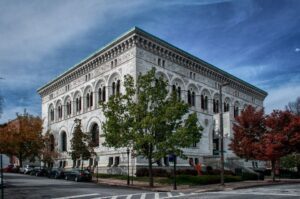
This is, in part, due to the Curatorial Practice MFA program at the Maryland Institute College of Art. It was the first such degree in the United States, and is a furnace of invention that has broken and recast the discipline’s very meaning, from that of opaque, academic specialism to accessible component of social justice and reformist thinking. Vitally, Baltimore itself is an intrinsic aspect of the course, wherein students are encouraged to research and connect with local organizations, public spaces and grassroots movements—or form their own. At its best, this binds artistic exploration with the city’s socio-economic conditions, its heritage and its racial and civic histories and priorities. In turn, school and city can be valuable cross-pollinators—residents and the art and cultural scene benefit from students’ inventiveness and ideas, just as students imbue knowledge from the rich fabric of Baltimore’s cultural laborers, and agitators; its plights and successes. All of those featured herein are either Curatorial Practice graduates, teach at MICA, or both. Its impact on Baltimore’s and America’s creative ecosystems—even as the school grapples with its own past failings—mustn’t be underestimated. The program’s success is such that it could (ironically) usher the redundancy of curating as it has been traditionally understood.
These practitioners are curators, yes. They are also historians, archeologists, writers, and community organizers. They are fundraisers, business owners, critics, activists, anthropologists, researchers, artists, demonstrators and orators, who utilize their curatorial prowess only as one element of the heavy arsenal that is required to meet today’s challenges. Their union of cultural and intellectual scope, ethical awareness, and inexhaustible commitment to their causes, positions them in the vanguard among today’s foremost creative leaders.
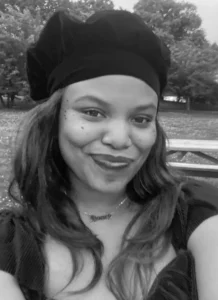
Tiffany Auttrianna Ward’s curatorial and literary initiatives are focused on elevating artists throughout the strata of the African Diaspora. Ward’s central aims are to foster meaningful conversation between Black, Latinx, Latin American, and Afro Diasporic artists through shared ancestral inheritance and lived commonalities, while also exploring their differences. In doing so, Ward aims to bridge the historical and geographic divides that have stymied such reciprocity, throughout the Americas, the Caribbean and internationally.
“I work to shift conversations about Blackness and the African Diaspora—encouraging more expansive discourse—both in terms of history and contemporary art. I have seen thorough-lines in the discussions that Black and Indigenous artists are having, and it is imperative that these conversations and cultural connections are highlighted. That is a founding principle of my exhibitions, publications and residencies.”
Water, oceans, tributaries—their proximity to places she has lived, and their role in migrational themes—particularly the brutal currents of the transatlantic slave trade—are a factual and poetic underpinning of Ward’s practice. In 2019, she established MARE (“sea” in Latin) a nomadic residency program, as a vehicle to ally the groups and individuals she cherishes, and to share those endeavors across the continents in which their stories are told. In a little more than two years, MARE has hosted Luis Vasquez La Roche (Port of Spain, Trinidad and Tobago), Yelaine Rodriguez (New York, NY), Jerrell Gibbs (Baltimore) and Bia Rodrigues (Recife, Brazil), to name a few, in Puerto Rico, Baltimore and New York-based iterations. Integral to Mare’s sessions is Ward’s belief in the value of intergenerational exchange, mentorship, and the passing of knowledge between artists. In this, MARE parallels the very channels by which (particularly lesser-known) chronicles of Afro Diasporic lineage are highlighted and preserved.
“I founded Mare Residency with the goal of celebrating Blackness in all of its facets. In the two years prior, I facilitated interviews with artists about their experiences in residencies and what their ideal residency would entail. I wanted to create a space that would be artist-responsive and specifically supportive for Black artists. I decided that the residency should be roving because I think the communities Black people have built hold significance. I also wanted all of the participants to connect with the local art scene, which is why every residency session has an artist from the local community.”
Ward blends personal fortitude, insight and inquisitiveness with a professional ardor that has enabled her to build an extensive network of colleagues, locations and projects. She is currently based in London—nexus of the fallen British Empire. In the late seventeenth century and through the eighteenth—after the Portuguese, Dutch and Spanish—Britain and France became the most prolific exploiters of the slave trade. Ward’s time in the United Kingdom has been spent researching and outreaching, but it has also brought unexpected private reflection. The latter, when Ward visited Greenwich Docks. There, her intuition and empiricism brought awareness of an atmospheric residue, an echoing through time that locations of mass anguish often retain. The statistics that have left their mark on the very air (imperceptible to most in the Eastend) are on an incomprehensible scale. Royal Museums Greenwich notes that between 1662 and 1807, Britain transported nearly 3.5 million enslaved Africans across the Atlantic to the Americas—the Middle Passage—with close to half-a-million people not surviving the crossing. In a little over a hundred years, there were 12,000 transportations on British registered ships, with London and its waterways as the origin for almost 3,500 of those. Ward’s inextricable sensitivities to the legacies fueled by these numbers only enrich her abilities as a steward and champion for the inheritances and acknowledgment of displaced African peoples, and the artists who keep their narratives alive. In situating herself along these spiritual lay lines as a Black woman of power and influence, Ward contributes to the turning of ancient and melancholy tides.
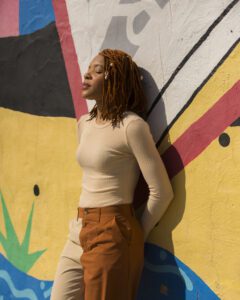
Deyane Moses is a veteran, an educator, a journalist and a civic visionary who works to preserve and disseminate Black histories in Baltimore and across the United States, establishing means by which the lessons of yesteryear can encourage future equality. To wit, Moses created “Blackives: A Celebration of Black History”, as her 2019, BFA (photography) thesis exhibition at MICA. Her aim was to highlight prospective Black students who were denied places at the school between 1891 and 1958, due to a discriminatory entry policy which sought “reputable white pupils”, and to engage the school’s Black student and staff bodies. The project, and related ventures—particularly the memorial action, “Take Back the Steps” in 2019—compelled MICA to apologize for its past offenses. Moses developed the original exhibition into the Maryland Institute Black Archives (MIBA), a staffed and funded collecting repository committed to MICA’s, and the city’s, Black communities from the 1800s to the present day. The archive includes artworks, data and records, photography, events, portraiture and oral histories. MIBA’s importance is sharply underscored when one considers that even in 2018, of 2124 MICA students, only 169 were Black, in this sixty-three percent majority Black city.
“I’ve researched and shared the Maryland Institute College of Art’s Black history and its role in higher education for Black artists through the creation of the Maryland Institute Black Archives (MIBA). I am particularly passionate about this topic, not only because I am a member of MICA’s Black community but also because the systematic erasure of Black history, people, and culture has negatively impacted my pursuit of higher education. In fact, MICA white-washed the subject entirely in their 350-page autobiography, printed in 2010. I created MIBA to uncover, preserve, and memorialize Black history and culture at MICA. Having observed MIBA’s impact on students, the campus, and art history, I am a firm believer that one of the best investments that colleges with problematic histories can make, is to rectify their racist pasts and to move beyond apologies, toward teaching their own histories through a socially engaged practice.”
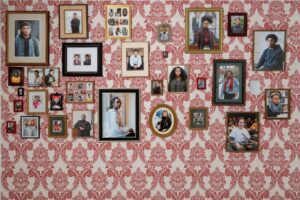
In 2020, Deyane and MIBA resurrected “Tom Miller Day” (February 18th) which had been established in 1995 by then Baltimore Mayor, Kurt Schmoke, to honor the life of Thomas Patton Miller (1945–2000), a Baltimorean artist, who minted the phrase “Afro-Deco”, to describe his work’s bold, expressive motifs and vivid palette. Miller was well-known locally by the time he died of AIDS-related complications, but had remained unheralded as widely as he deserves to be, partly due to the lapsing of Tom Miller Day. MIBA’s curatorial team worked with community members, politicians and Miller’s family, to expand the celebration into a week-long series of events, which now begin on February 14th each year.
Moses is also the Public Access Archivist for Afro Charities, a nonprofit of the AFRO American newspaper. Founded in 1892 by the formerly enslaved, John Henry Murphy Sr., the publication achieved international reach, and is the most enduring newspaper in the country dedicated to Afro American news and communities. 128 years after its beginning, the newspaper is still managed by its founder’s progeny. Formerly, Moses was the Inheritance Baltimore Community Archives Fellow at the Johns Hopkins/University of Baltimore Community Archives Program; and she is the Founder of Blackives LLC, with a mission “to provide historical research, archival services, and knowledge mobilization for Black artists and communities.”
Moses also teaches Archival Activism at MICA, passing on to her students the sense of curiosity, mission and vigorous questioning of art and its mechanisms that she expressed as a Curatorial Practice MFA candidate there. Perhaps that is one of Moses’ greatest strengths, having witnessed different conflict zones—literally, when she was stationed at Camp Casey, in South Korea, close to the DMZ; but also urban and cultural. She is unafraid to enter the defensive privations of contemporary fine art, critiquing its remoteness—language, canon, white history—while drawing from it those qualities that are most conducive to presenting her ideas. In this, Moses strikes an effective balance between reinvigorating and managing the strange dichotomies of an archaic art system.
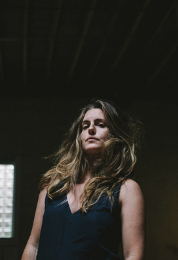
Babette Pendleton’s motivations form a confluence of time dilation, dance and performance, with the body acting as intermediary between the tangible—location, environment, site-specificity—and the ideological or enigmatic. Pendleton describes the distillation of these processes as the inherent “liveness” of a project’s intentions—its capacity for connectivity, its materials, and the presence it may leave upon mind and place.
Collaboration is a central component of Pendleton’s approach, stemming from her work as a choreographer and organizational director. Her public practice is influenced by her own artistry which she characterizes as “roving physical collages—visual narratives involving performance, sculpture, photo, and video.” Pendleton employs these skills to mull the ethics surrounding art forms that are too often considered unpreservable. Here, she navigates the difficult path of encouraging public perception of human gesture, flux, and ethereality toward the substantive, consequential, and as having the potential for lasting sociological consequence.
“I believe in the power of long-form, slow time to harness richer experimental work, improve impact, and build sustainable working methods that counter the fast consumerist-driven curatorial practices often utilized today.”
Pendleton aims for practical solutions regarding the care of art, artists and audiences. She is currently researching how contracts between artists and museums, collectors and galleries could be overhauled to safeguard artists’ rights, economic parity and how art that isn’t as commodifiable as painting or sculpture, can be acquired, protected and presented fairly. How could a fleeting performance be bought, stored and canonized—even as the artist who created it ages and dies? Might a proxy perform it? How would its integrity be maintained? Does a work without physical objecthood deteriorate, and if so is that a part of its life? Pendleton’s inquires probe commodity bias, or what could be considered the hierarchy of disposability—the requirement of a “something” before value can be established—leading us perhaps towards a more helpful “anything”. Pendleton’s metronomically-inclined thinking is, incidentally, in rhythm with the inexorability of the metaverse which places her, paradoxically, ahead of her time.
“Curatorially and artistically, the crucial thing that’s emerged is slowness, not in a tempo kind of way, but in an intention kind of way; and right now, my mind is wrapped up around ecological questions regarding care for ourselves and the land”.
Pendleton’s interests in managing art spaces and supporting emerging artists were accelerated in 2014, at New Tomorrow, an experimental art space in Seattle (formerly TMRW Party). There, she learned how to “honor the lineage of an organization while cultivating new pathways.” In 2018, she became the Director of Yellowfish, a performance art festival designed around time—not only as concept, but as durational medium—equivalent to more traditional materials. In this vein, Yellowfish provides a crucible for practitioners to share, experiment and discourse ideas across multiple sites and in various formats. Programming and events for Yellowfish’s 2020/2021 series were themed “To Stay Alive /| You Must be Live” and lasted an epic nine months. Currently, she is the Exhibitions and Programs Associate at the Corcoran School of the Arts and Design, in Washington, DC. Even in these duties, she applies notions of corporeality and mutability in surprising ways, thinking of the very buildings where she works as bodies with internal organs that require nourishment to sustain their development as sites of cultural ignition.
Imani Y. Haynes’ curatorial projects proceed from the immense value she places on storytelling, with which she explores the shared experiences of Black women—their selfhood, how they have lived, survived and flourished with determination and courage, despite carrying the burdens of generational fatigue and the subjugation—eradication—of their contributions to American life. In centering material, oral and personal remembrance of those cultural and political progenitors, Haynes looks to the tantalizing prospect of who will come after, and what they will achieve, while working to provide places of access, celebration and pilgrimage.
“As a historian I love to cling to facts, and I utilize my love for the arts to build an anthropological map that brings our humanity to the forefront. My concentration is on the cultural experience of the Black Woman—the ugly, the beauty, the quirks that make us who we are; the things that make us a tribe.”
Haynes’ stance would be prescient and urgent in any era, but from today’s perspective, when the centuries-old white patriarchy is fracturing as never before, and as it panics itself into political obscenity in its last-ditch attempts to retain power, her work is of particular resonance. In 2019, Haynes founded the Black Woman’s Museum, to celebrate and restitute Black women to their rightful places as aspirational local and national leaders via exhibitions, illuminating historical events, and educational programming. The absence of Black women as role models, was something keenly felt by Haynes during her formative years. That confounding lack of acknowledgment, of exclusionism and of names and faces who she would have been able to relate to, is something that she seeks to redress by providing visibility and disseminating knowledge for and about Black Women, her primary audience, and the public at large.
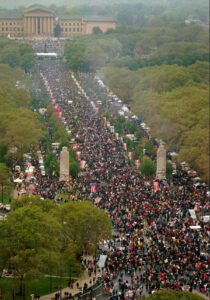
“I see the experience of a Black Woman like a quilt, weaving in the experiences handed down by our ancestors coupled with our lived experiences constantly adding to the fabric that makes us who we are.”
The Black Woman’s Museum is a roving project, housed in a forty-feet long shipping container; a carefully considered vessel that enables site-specificity as an integral part of the museum’s outreach. It’s a profound choice, in that it notes the harrowing circumstances of forced migration, labor, commodification and constriction that have inflicted such legacy trauma on Black Americans and the African Diaspora. Yet, Haynes’ deft decision to open both ends of the container during exhibitions—making it a conduit, an open space to be freely wandered through—undermines supremacist remanding. The museum then, is both a space for wistful remembrance, and dynamic future prospecting.
“I want Black Women to be free, no longer managing societal pressure so well that it becomes a part of our daily condition; I want the Black Woman’s Museum to be one of the many places we can go to get healing.”
In 2020, the Black Woman’s Museum in partnership with The National Great Blacks in Wax Museum in Baltimore, presented “The Million Women March”, an exhibition that upraised the 1997 March for Black Women, that took place in Philadelphia. Intended to prevent this under-acknowledged event being further eroded from public consciousness, the exhibition incorporated first-hand accounts by attendees; responses by artists Katelyn Brown, Latoya Hobbs, Aiesha Myles, and Asrianna Simmons-El; and flags made by students at Baltimore’s Western High School. In addition to her work as a historian, curator and arts administrator, Haynes is the Education Program Manager at the Josiah Henson Museum and Park, in North Bethesda, Maryland.

Dulcina Abreu is an independent curator, artist and museum advocate, born and raised in the Dominican Republic. Having relocated to New York from Santo Domingo in 2014, she is now based in Baltimore. Abreu’s early interest in dance and performance has evolved into a multi-layered career fueled by her faith in the potency of collective action. Abreu’s keen historical awareness, intellectual vigor and unyielding sense of social justice for marginalized communities are central to her initiatives. She works across several interrelated fields of enquiry including 21st century visual and material culture from the Caribbean Diaspora; immigration; community organizing; and mutual aid activism.
“Generally speaking my role as a cultural agent in recent years has been dedicated to locating Latinx stories of resilience.”
The importance of public engagement was crystalized during Abreu’s BFA studies at Parsons, The New School. Seeking a sense of home, of familiarity in a new country, Abreu’s studio became a place of refuge and exploration that met both artistic and personal needs. Working late into the evenings, the artist got to know the studio building’s janitorial staff who were largely Dominican and Puerto Rican. Bonding through stories of common experience, Latin American music, and blue-collar values, she realized the parallels between their jobs, and her own—“labor, cleaning, erasing—I was painting, and so were they.” Abreu’s work space became an installation, evolving conceptually and literally along an arc of working-class industry. For the performance, Skin Between, the artist sanded, then painted the walls with a flesh-toned pigment and latex “skin”. Later she pinched and nicked (as if at a wound) digging and peeling away sheaths in which she, nude, wrapped herself, as if returning to the womb. The work incorporated restoration, sensuality, retreat, rebirth, choreography, and ingress. It was during a second version—Skin Between II—that Abreu invited the audience to make their own punctures and lacerations, thereby tasking many bodies in shared endeavor, and uniting artistic investigation with the public action that is so intrinsic to her thinking.
“My work is devoted to creating spaces for community building, spaces to talk about resistance and identity through archiving, online residencies, performance, and dance interventions. In early performance pieces such as “Lady Walk” or “Cartografia” I play in between representation and translation of the aesthetics of Dominican labor in New York. Each piece is inspired by transcultural phenomena around construction craftsmanship or basic assembly line performance.
Abreu is a powerful voice in the movement to restructure museum and institutional frameworks away from their racist and economically predatory mechanisms, which continue to disproportionately sideline and take advantage of BIPOC workers. Her political acumen makes Abreu both an expert advisor on laying foundations for traction and progress, while enabling her to remain vigilant and instructive when those bodies misstep with regressive or damaging moves—superficial pronouncements of support for BIPOC workers, box-checking tweaks to existing practices—that worsen, rather than address, these issues.
“One of my latest projects, On Possible Futures, encompassed a digital public programming series that explores Queer and BIPOC digital activism and mutual aid initiatives during COVID-19. The project created a global network of courageous efforts by BIPOC artists and museum workers confronting institutional statements “on solidarity,” in addition to governmental policies that increase the impact of the current global health crisis and perpetuate systemic racism. The platform ended up developing five virtual discussions with global panelists and over twelve partnerships. A publication based on the conversations is in the works, and a documentary of their experiences during and after the pandemic.”
“On Possible Futures” demonstrates how Abreu’s utilization of digital technology to pool the resources of like-minded thinkers, industriousness, and proficiency within such tectonic subjects are raising her to the level of an international cultural ambassador. In addition to her independent work, Abreu is the Consulting Curator for “September 11: An Evolving Legacy” at the Smithsonian’s National Museum of American History; she is the Co-founder of the International Coalition of Museum Professionals and Communities—with Armando Perla; she manages the NYC Latino 9-11 collecting initiative and the NYC Latino COVID-19 Project; and she is the Exhibit Coordinator for the Latinx Youth Movements exhibition and collection at the Molina Family Latino Gallery, National Museum of the American Latino.
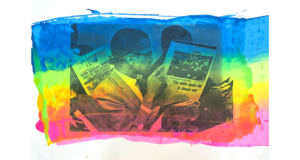
Joseph Orzal is a Filipino-Mexican American artist, curator and activist who works in Washington, DC and Baltimore. His core interests lie in engaging with the consequences—political, societal, monetary—of racial, sexual and class bias; the protection of, and advocacy for vulnerable constituencies in the DMV region and nationally; and political education and civic rights awareness. In his studio practice as a painter and sculptor he explores the inviolability of humanness and our emotivity in response to personal or cultural stimuli.
Among his curatorial aims is creating less complicated relationships between art and its audiences via exhibitions that welcome and encourage, rather than hew to the duplicitous positioning of privileged opinion on art and its themes as almost celestially ordained—and therefore “correct” and incontrovertible. In this, Orzal seeks to devolve power from a fractional set of gatekeepers, into the hands of many for whom art and its implications could become an integral aspect of daily life—not an icy and distanced unknown that seems outside of their experiences.
“the field of curation has been saturated by whiteness, nepotism and privilege, so, usually what happens with that is you don’t get a lot of creativity beyond regurgitation of the status quo. The field is overdue for an overhaul, which excites me because of how little innovation there has been. The possibilities are endless.”
Orzal believes in the egalitarian nature, political capital and relatability of art as a mode of progress and cohesion—qualities that are often forfeited to the commercial machine. Orzal also confronts iniquities in the gallery and museum system that caters primarily to the rich, and contributes to a stagnancy that often keeps artists in cyclical poverty while plundering their objects for private gratification. Here, Orzal speaks to the oft-claimed intentions of public inclusion and societal care in press releases and exhibition catalog essays, that in practice don’t engage purposefully with real-world problems outside of the crisp white cube. He notes that:
“I believe that art has the ability to disseminate complex information in simple and refreshing ways. Especially in the field of political education. Aesthetics are an incredibly powerful tool in political persuasion and I am interested in how we can build new aesthetics, narratives, and exhibitions that aim to educate, inform and empower people towards action rather than mystify and fetishize art objects. “
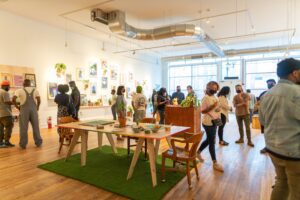
Orzal’s studio practice evolved to encompass curating out of necessity, due to a lack of opportunities and venues that were supportive of his aims, and those of his colleagues and peers. The development of alternative platforms to sidestep institutional intransigence is indicative of his concern for the visibility of other artists and of his pioneering spirit. As a platform for these concerns, Orzal co-founded NoMüNoMü, a forceful and invigorating collaborative dedicated to confronting unjust and exploitative orders inside the art world and in society at large. NoMüNoMü’s team is adept at harnessing the visual aspects of building or branding a collective, particularly its dynamic online presence. The group’s website, social media accounts and poster campaigns have established it as an instantly recognizable symbol of rainbow-hued resistance to creative, economic and racial inequality and persecution. NoMüNoMü’s center of operations on the city’s N. Howard Street functions as a gallery, a meeting house and a hub of local organizing. The collective hosts music events, workshops, exhibitions, book launches, panel discussions and more. In addition, there has been advice on rent striking, tax preparation, mental health, the wealth divide, fostering progressive social architectures, and challenging museum hierarchies. NoMüNoMü partners with other grassroots cooperatives such as Skarie Studio, MUMBO Connection (advocating for Black women in leadership roles), and Black Artists Research Space (Bars).
“I think being able to bring people together and create dialogue about now is very exciting because it feels very end-times. There’s a sense of urgency but also exhaustion and confusion. Being able to create a forum for people of different backgrounds to join together and examine the present moment is going to be crucial for all of us. I think curators—who have access to space, artists, community and history—will be able to really help bring forward contexts that can prompt action. So I am excited to be a part of what is to come.”
Last year, Orzal (in collaboration with artist activist Justin “Yaddya” Johnson) published Long Live Gogo: The Movement #moechella. The book celebrates and stakes Gogo music and culture in Washington, DC’s Black communities, and the Moechella political activist initiative which aims to safeguard Gogo’s heritage and future from being buried beneath the nefarious consequences of rampant and relentless gentrification.
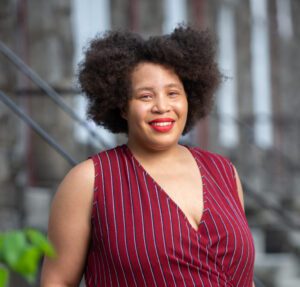
Joy Davis’ creative métier was spurred early by guiding aspects of her parents’ dispositions—her father’s curiosity and criticality, allied with her mother’s practicality. Davis has honed these propitious approaches in her career as a curator and a curatorial director, specializing in media, culture, fashion and histories of performance among people of color. Davis is also an independent scholar of cultural and fashion history. Her generosity toward those artists, peers and colleagues with whom she partners combines pragmatic support with intellectual philanthropy—the sharing of knowledge and experience toward amplifying those of others, and fomenting beneficial discourse. She cites several anchoring themes:
“My focus as a curator is three pronged: 1. Uplifting marginalized voices to the best of my ability and provide space to support their work through exhibitions. 2. Telling Black and multicultural stories. 3. Being a resource to educate and advocate for artists and art-workers.”
In 2017, Davis opened Waller Gallery, (a name chosen to honor her family’s matriarchal heritage) in Baltimore, as a cynosure to action these principles, with a focus on supporting artists of color. In keeping with Davis’ own expansive interests—she holds BAs in History, and Media Studies, University of Maryland; and an MA in Fashion and Museum Studies, Fashion Institute of Technology, New York—the gallery’s ethos steps beyond that of a typical contemporary art space. Waller Gallery’s credo that it considers “all forms of art” and shows artists at various career stages is in fact a radical and refreshing stance that signals openness and possibility to prospective collaborators that their ideas, their concerns and their modes of expression are welcome. With this model, Davis tackles the stringency and hyper-sensitivities of the art world’s narrow dictates on what the aesthetics and machinations of gallery business ought to be, instead pressing forward with what can be. These tacts are parallel to Davis’ belief that, whether within the art world or elsewhere, formal education, wealth or station are not the singular route to personal or professional achievements.
“Value doesn’t just come with having a degree or social capital”.
Waller Gallery has presented craft, design, fashion, digital art, archiving and textiles; the space has exhibited artists from Make Studio—an organization offering studios to artists with disabilities; and the gallery has an art advisory service that assists collectors. Davis’ entrepreneurial outlook is also in sync with her enthusiasm for the necessity of Baltimore’s Black-owned businesses. This breadth and commitment is exemplified by Waller’s programming. For example, In 2018, the gallery exhibited “Drapetomania” by Baltimore artist, filmmaker, teacher and photographer, Nia Hampton, which presented Hampton’s photographic documentation within Afro Latino communities, and included installation, video, and an onsite film festival. Hampton showed images of her time in Brazil, and her travels and experiences in South America, where she engaged with such issues and subjects as environmental racism, African spiritual rites, and femicide—the murder of women based on their gender. Davis’ aim for the gallery to be a center of information and exchange is underscored on its website which holds a bibliography on femicide, drawn from that portion of Hampton’s exhibition. From the show’s press release; “Drapetomania was once a medical diagnosis used to explain why enslaved Africans ran away from the plantation. This was a racist and fabricated diagnosis of the human imperative to flee servitude”.
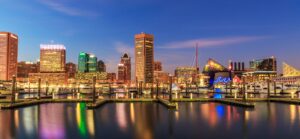
Davis’ stance that it is vital to “pay people and be transparent” confronts another art world sickness; the conditioning that what artists do is too noble for them to expect something as base as payment in return for their efforts, and so, the confidence to ask for compensation is rarely developed. Historically, degree-level art education has done little-to-nothing to counter this notion, let alone assist students in the business aspect of being an artist, or how to make a living from their cultural production, so that whether passively or aggressively, those learning institutions compound what becomes a life-long, disadvantaging mindset.
Since 2015, Davis has co-hosted and produced Unravel (founded by fashion scholar Jasmine Helm and textile conservator Dana Goodin) as a platform to explore and discuss the history and quotidian relevance of fashion, through sharing academic insights and discoursing with guests. For Davis, Unravel offered the opportunity to reach a wider audience, and in an additional format to her published articles. Davis has taught Art History, as well as Intercultural Practice, at the Maryland Institute College of Art and is currently teaching Art Matters—which considers how art professionals question art, architecture and design.


Good points but I’d like to add the following which is equally important. While racial issues are of prime importance, if art was about social justice then we could dispose of the word propaganda. In ‘Autopsy of an Art Magazine” I pointed out how focusing on social justice killed an art magazine that had published for 83 years. So if art is not about social justice and politics, what is it for? Curators are often intellectuals working in the territory of verbal language, but in art the only verbal language is writing. In images it’s visual language, in dance it’s body language, and in music it’;s acoustic language, and there is no way to explain those in words. In fact, art is often what we could not say in words. Art is also what we cannot think about but have to experience.
Now Walter Benjamin said the only true art is that which is made by a committee of the working class. I think Dialectic Materialism is cultural tunnel vision. While curators who are socially conscious are necessary, art is about something that has little to do with politics but is just as important. Art is also about the individual’s reach for a higher purpose, a higher expression, it’s about soul, as in Miles Davis, Oscar Peterson, Louis Armstrong, Prince… The etymology of art is specifically value-descriptive. It describes an impressive quality of spiritual expression, achieved through an outstanding mastery of skills by extraordinary people.
Thank you for commenting but would you let us know your name?
Hi Daniel, there’s a problem with Chrome that it logged me in as anonymous. I had to come to Firefox to answer. I wanted to address the issue further as I was reading to day about ecology. Now in the Baltimore article, I agree that racial issues are urgent. In my article I mention that I am fine with Canadian art opportunities being diverted to First Nations people, as the Art Gallery of Ontario said that 1 in 3 exhibition will be for First Nations artists. I see that as an equitable move to set a career balance to First Nation Canadian artists, who were at a racial disadvantage in Canadian culture.
Very powerful perspective!